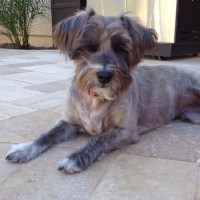Appearance of the Cairnese
|
| The Cairnese is a small hybrid between the Cairn Terrier and the Havanese. Your Cairnese will measure between 20 and 33 centimeters and weigh between 4.5 and 9 kilos. The Cairnese has small but sturdy legs and small ears in the shape of a triangle that turn over. The eyes of the Cairnese are slightly larger than those of the Cairn Terrier, and are dark in color with a cheerful expression and bushy eyebrows that add to the happy expression. A Cairnese's muzzle is of medium length and the black nose is round. A Cairnese's tail is full, like the Havanese, but short, like the Cairn Terrier. |
Temperament of the Cairnese
|
| Cairneses can resemble the Cairn Terrier or the Havanese, and have medium-to-high energy with moderate intensity requirements. This mix requires daily exercise of moderate intensity. They are intelligent dogs, but the Cairn Terrier parent has added elements of independence and stubbornness, making the Cairnese a little more difficult to train if it resembles the Cairn Terrier. The Cairnese is a high-energy companion dog. This hybrid is affectionate towards its family, including children, and is a moderately sensitive dog that won't tolerate being left alone for long. As far as strangers are concerned, the Cairnese is friendly and welcoming, and enjoys the company of other dogs and pets. The energy levels of the Havanese parent are lower than those of the Cairn Terrier. However, daily exercise is necessary and just as essential to stimulate the Cairnese's spirit. The Cairnese needs moderate-intensity exercise. Although the Cairn Terrier can be a stubborn breed, the Havanese parent equals independence and makes this mix easier to train. |
Needs and activities of the Cairnese
|
| The Cairnese has a lot of energy and needs daily exercise. However, the parent breed Bichon Havanais is a more laid-back breed and can soften the Cairn Terrier parent genes in your Cairnese. If the Cairnese gets enough daily exercise, this hybrid is well suited to apartment living and much of its exercise needs can be met at home. This hybrid doesn't need large spaces to run around, but a small backyard is ideal. The Cairn Terrier is known for digging and rooting, so proper exercise and mental stimulation are essential to prevent destructive behavior in your Cairnese. Daily play and exercise also strengthen your bond and keep the Cairnese's mind properly stimulated. The Cairnese is a versatile dog capable of living quite well in any climate. |
Maintenance of the Cairnese
|
| The Cairnese is not a hypoallergenic dog and throws lightly to moderately, depending on which parent breed it most resembles. The Havanese is not a heavy excreter, unlike the Cairn Terrier. The medium to long hair of the Cairnese requires daily brushing to avoid tangles and matting. Regular ear cleaning with a vet-approved solution will help prevent ear infections in your Cairnese, and brushing your dog's teeth at least twice a week to prevent dental disease and keep his mouth clean. The Cairnese doesn't drool much and keeps its coat and teeth clean of any "doggy" odors that may arise, although this hybrid is not known for smelling. |









 English (United Kingdom)
English (United Kingdom)